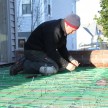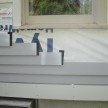Installing Snow Melting Cables
Heated Walkway Using WarmlyYours Snow Melting Cables [Part 2 of 2]
Whether you are designing a heated asphalt, concrete or paver driveway, WarmlyYours has the snow melting solution for you.
READ Part 1 of this article
No more driveways or walkways to shovel or plow. The paving material absorbs heat from the snow melting heating elements, melting the ice and snow while you relax. There’s no need for expensive deicing chemicals that can reduce the life of your driveway. And, your family, guests or customers can visit you safely.
Considering the nature of this system, the best time  for installation would be during a new home project, or major landscaping changes to the property. If old, cracked walkways need replacing, then would be the time for this type of installation.
for installation would be during a new home project, or major landscaping changes to the property. If old, cracked walkways need replacing, then would be the time for this type of installation.
Project Specifications:
This project used 251′ of cable spaced approximately 3″ apart. The system is a 3000 watt, 240 volt, 12.5 amp system. Warmly Yours sent me the following as part of the premium system sent me:
- Relay panel
- Premium snow melt control panel
- Snow sensor
Electrical Requirements:
To install this system the electrician needed to install 1 – 20 amp. 240 VAC breaker and 1-15 amp. 120 VAC breaker.
Walkway Preparation:
1. The old cobblestones were removed and we made sure there was a good solid base for the new walkway. There was already a base of 12″ of stone dust under the cobblestones. We placed 4-6″ of compacted gravel to bring the level up and then 1″ of sand on top, leveling and compacting with a plate compactor. It is important to pack the base to eliminate stone shifting.
2. I copied the old width and length of the walkway.
3. Find the center point of the bottom step to locate the center of the walkway. Drive a spike into the ground at this point. Tie a piece of string to the spike and pull a straight, taut line to a spike at the other end of the walkway. Use a square to make sure the line is straight. Measure out from this center line at various points to locate the edges of the path. Mark both edge lines with marker paint along the entire length of the walkway.
4. Excavate the area inside the edge lines to a depth of 6″. We power tamped the entire walkway. Add and tamp l” layers of gravel  until there is a firm 3″ thick compacted gravel base. Spread and level a 1″ layer of concrete sand over the gravel base.
until there is a firm 3″ thick compacted gravel base. Spread and level a 1″ layer of concrete sand over the gravel base.
5. A tent and heater was used to keep us, the sand and the gravel from freezing. It also kept the mortar on the landing warm. You’d be amazed at how warm it was in the tent.
Installing The Snow Melt Cables:
1. The heating cable was then installed in a serpentine pattern, similar to the landing and step. I secured the cable to the stucco wire mesh with plastic tie wraps. I took precautions not to overlap the cables at any point to avoid possibly overheating the cables. Minimum spacing of the cable s 3″ and the maximum spacing is 12“.
2. I installed the cable at a depth so that it would not be deeper than 2 1/2” from the top of blue-stone. The snow melting heating cab le rests in a 1″ bed of mortar we installed galvanized stucco type mesh to the landing and step with tap-con screws.
le rests in a 1″ bed of mortar we installed galvanized stucco type mesh to the landing and step with tap-con screws.
3. We made sure to allow sufficient drying or curing period of the floor / slab / concrete / asphalt after installing the Heating System and before energizing the Heating System.
4. It is extremely important that the blue stone installer does NOT use any heavy equipment, machinery, or vehicles over the exposed Heating Cable. During the paver installation process, it is recommended that care be taken to avoid stepping on the hot-cold factory splice portion of cable (green meets black).
5. Care must be taken by the blue stone installer so the mortar covers the Heating Cables / Mats and they will not make direct contact with the blue stone . We recommend that at least 1.5” (38mm) thick mortar is poured over the Heating Cables / Mats, but no more than 2”(51mm).
6. The blue stone installer(s) must take care not to walk on the hot-cold factory splice and to avoid damaging the Heating Cables w ith shovels or rakes.
ith shovels or rakes.
7. It is the responsibility of the electrician to use a 500 VDC megohmmeter and a multi-meter to continuously check on the Heating Cables that are currently being worked on top of, to ensure they have not been damaged, and will be ready for action once the mortar pour has cured.
The electrician needs to complete final testing of all the Heating Cables / Mats with a multi-meter and a megohmmeter to verify and record that each Heating Cable has survived the pour of mortar, and is ready for action once the mortar is cured.
Installation Under Bluestone Pavers:
1. Before setting the blue stone, establish a guide line along one edge of the walkway. This ensures that the stone is laid in a straight line.
2. Decide what pattern you want to use in the design of your walkway. A popular pattern, for instance, is herringbone. Blue stone is usually laid in a pattern and we used a running bond pattern. [similar to a brick wall] The pattern you decide to use will determine the size and shape of the bl ue stone tiles you need to purchase.
ue stone tiles you need to purchase.
3. Set stones in place starting at the base of the steps. Use a rubber mallet to tap each piece securely in the sand. Check each stone for level and maintain a consistent gap between stones for an attractive look.
4. We added a mortar mixture along both edges to help prevent erosion issues and to help hold the blue stone in place.
5. Full pieces should be laid first and all cut pieces last.
6. Blue stone joints were filled with a colored sand.
- Energy consumption will vary depending on ambient temperature and building insulation. For lower energy consumption, use a 7-day Programmable Thermostat control.
- Energy consumption can be minimized by turning the system OFF when heating is not required, but extra time will be required for the slab to warm up once the system is turned ON again.
- Avoid placing objects like thick mats on the heated slab, especially in the area where the floor temperature sensor is located. These restrict the transfer of heat away from the Cables and result in the floor area beneath them being warmer than other areas.
- Avoid Mats with rubber or vinyl type backing as these may decompose with heat and could stain flooring.
My experience Installing the Warmly Yours Snow Melt Cables:
1. Design process and project management:
I found the installation instructions really easy to follow and understand. I did have a few questions and needed to call my project manager, Matthew Caruso. All of my questions were answered thoroughly and promptly which is a huge plus when your working on a project with deadlines and other contractors involved.
Every project manager is involved in a Warmly Yours design. They approval of the design with you and follow the project to the end. I was impressed with the level of customer attention and service Warmly yours provided.
2. Installation of the product:
The cables were super easy to install. I used plastic tie wraps and secured the cable to metal stucco mesh. It was that simple. Warmly Yours spelled out what to avoid and how to install the cables.
The electrical portion of the project was handled by an electrician. The system runs off of 240 volts. I made and installed a mounting board for the Warmly Yours controller
Advantages Of A Snow Melting System:
Overall Impression:
The system for this project costs approximately $2400 MSRP. I found the company super easy to deal with, and the product easier to install. From start to finish installing the Warmly Yours snow melting system cables took six hours and six hours to install the electrical wiring.

Tonight it snowed and I took a picture of the walkway. Everywhere else had an inch of snow and this walkway was clear, snow never accumulated on the walk or stairs. I was very impressed.
Two days ago we experienced a blizzard with 30 to 50 mph winds and snow amounts from 10 to 16 inches. The duration of the storm was approximately 20 hours. The walkway turned on right when it started snowing and stayed on until 4 hours after. I installed the snow sensor that morning and tested it on this storm – it worked great!
During the blizzard I observed a few things that you might find interesting:
This storm dumped a lot of snow fast and was a perfect test for the Warmly Yours Snow Melt System. There were several hours of 2-3″ inches of snow per hour. During these times an inch of snow was on the walkway as compared to 8-10″ inches on everything else. The homeowner shoveled the walkway twice [1″ each time] during this storm.
When I installed the walkway cable I was super diligent when spacing the cables, I installed them 3″ apart. Towards the end of the walkway install I was nervous that I may run out of cable so I began to space them 5 to 6″ apart and finished the last 18″ of the walkway this way. My observations during the storm were the section of walkway with the 3″ spaced wires melted first and stayed clear throughout the entire storm. The 4-6″ spaced wire section took a little longer to melt the snow and was covered with 1″ of snow during the blizzard.
Another observation was that the edges of the landing and step iced up slightly. I attribute this to the fact that the snow melting cables do not extend beyond the landing and step foundation. If you remember we stopped the heating cables in from the concrete block [foundation] edge. The landing then had stone veneer applied and an overhanging blue stone top. This means that there is approximately 4-5″ of landing edge and step edge that do not have snow melt cable directly below it and subsequently need time to warm up. They eventually did warm up and melt, but after the storm. A quick scrape with a shovel cleared this during the storm and the rest melted after.
Four hours after the storm the walkway was clear and dry with no residual ice or snow. The system worked extremely well in the harshest environment, I was super impressed!












